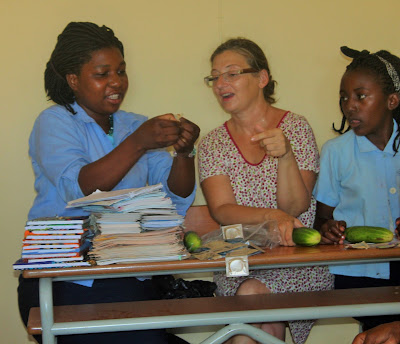One of my
secondary projects is facilitating a group of adolescent girls on topics of education and health
, this is a very popular and rewarding program for many Peace Corps Volunteers
and it is similar Michele Obama‘s mission of Let Girls Learn.
We just finished
a meeting on prevention of sexually transmitted diseases, especially HIV (The estimates
here in my village are higher than the national average of 11.9%).
We started
with having the girls practice what to communicate to their boyfriends on the
importance of health and preventing illnesses, thus the use of a condom. We had
a few giggles, but they understand their rights (gender equity was discussed previously)
to insist on the use of male condoms or female condoms. We ended with a demonstration
using cucumbers and condoms and then posed for a cherished picture.
These
girls will go far.@bloggingabroad
Here is more information on the HIV/AIDS epidemic:



·
According to WHO  , an estimated
35 million people have died from AIDS-related illnesses since the start of the
epidemic, including 1.1 million in 2015.
, an estimated
35 million people have died from AIDS-related illnesses since the start of the
epidemic, including 1.1 million in 2015.
·
Despite advances in our scientific understanding of HIV and its
prevention and treatment, most people living with HIV or at risk for HIV do not
have access to prevention, care, and treatment, and there is still no cure.
However, effective treatment with antiretroviral drugs can control the virus so
that people with HIV can enjoy healthy lives and reduce the risk of
transmitting the virus to others.
·
The HIV epidemic not only affects the health of individuals, it
impacts households, communities, and the development and economic growth of
nations. Many of the countries hardest hit by HIV also suffer from other
infectious diseases, food insecurity, and other serious problems.
·
Despite these challenges, there have been successes and
promising signs. New global efforts have been mounted to address the epidemic,
particularly in the last decade. Prevention has helped to reduce HIV prevalence
rates in a small but growing number of countries and new HIV infections are
believed to be on the decline. In addition, the number of people with HIV
receiving treatment in resource-poor countries has dramatically increased in
the past decade. According to UNAIDS  , as of
December 2015, 17 million people living with HIV were accessing antiretroviral
therapy (ART) globally, up from 15.8 million in June 2015 and 7.5 million in
2010.
, as of
December 2015, 17 million people living with HIV were accessing antiretroviral
therapy (ART) globally, up from 15.8 million in June 2015 and 7.5 million in
2010.
·
Progress also has been made in preventing mother-to-child
transmission of HIV and keeping mothers alive. According to UNAIDS  , in 2015, 77%
of pregnant women living with HIV globally had access to antiretroviral
medicines to prevent transmission of HIV to their babies; new HIV infections
among children have declined by 50% since 2010.
, in 2015, 77%
of pregnant women living with HIV globally had access to antiretroviral
medicines to prevent transmission of HIV to their babies; new HIV infections
among children have declined by 50% since 2010.
AIDS.GOV










No comments:
Post a Comment